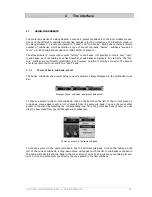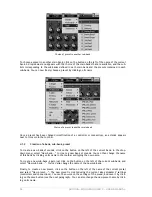
ARTURIA – MOOG MODULAR V – USER’S MANUAL
67
5 The
modules
The Moog Modular V can be broken down into 4 parts, from top to bottom, a section containing se-
quencer and effects, a section dedicated to the sound programming, a small extension where the
external cables are regrouped (velocity, after-touch, external signals...) and finally a section con-
taining the keyboard and different play settings.
5.1 PROGRAMMING
SECTION
5.1.1 Description
The programming section gathers all of the modules, which need to be connected by cables. It is on
this screen that the different connections (Patch) needed for the programming of the sound will be
made.
It is sometimes necessary to connect a module in the programming section to a module in the se-
quencer section. To simplify connections between the 2 screens, the inputs and outputs of the se-
quencer section are grouped on a small extension under the sound programming section.
•
The sound programming section contains:
•
Nine oscillators, grouped in threes, which can also be used as modulation source.
•
Two low frequency oscillators dedicated to modulations.
•
Three filters.
•
Six envelopes dedicated to modulations.
•
Two envelopes dedicated to output amplifiers.
•
A dual trigger delay.
•
A noise generator and the associated filters.
•
1 ring modulator
•
4 envelope followers
•
2 sample and holds
•
1 frequency translators
•
1 formant filter
•
A set of amplifiers, which can be grouped to form mixers.
The number of spaces at the upper part of the section being inferior to the number of modules, the
choice is made through a menu. It is thus possible to organize them at your convenience.
Summary of Contents for Moog Modular V
Page 1: ...USER S MANUAL Moog Modular V 2 ...
Page 4: ......
Page 8: ......
Page 18: ...18 ARTURIA MOOG MODULAR V USER S MANUAL ...
Page 52: ...52 ARTURIA MOOG MODULAR V USER S MANUAL ...
Page 85: ...ARTURIA MOOG MODULAR V USER S MANUAL 85 Independent mode Parallel mode Serial mode ...
Page 102: ...102 ARTURIA MOOG MODULAR V USER S MANUAL ...
















































